Andrew Eriki, the General Manager of Heritage Kanaani Farms, taking Business Focus team on a guided tour of the farm
The rate at which Ugandans are taking on large scale coffee farming is increasing by leaps and bounds. Heritage Kanaani Farms is the latest vast indigenous plantation to be set up.
Located approximately 18km off Buwama Trading Centre along Masaka Highway in Bunjako Island, Mpigi district, the farm sits on 900 acres of land, 300 of which are already planted with coffee.
The rest of the land is used for other income-generating projects including; eucalyptus trees, cattle, maize and fish farming among others.
As you approach the farm, you are welcomed by the beautiful scenery and fresh breath from Lake Victoria. The farm also has striking scenery, making it a good spot for agro-tourism.
On Saturday July 15, 2023, Business Focus team had a guided tour of the nascent and promising farm that has plenty of lessons for both small and large scale farmers.
Andrew Eriki, the General Manager at Heritage Kanaani Farms, says the farm is owned by Molly Twinomugisha Agaba, a Ugandan so passionate about agribusiness.
She acquired the land about four years ago using her personal savings.
Before acquisition, part of the land had some coffee that is being rehabilitated to increase its productivity. Eriki says his boss started by planting bananas (matooke) but after analysis, she realized the project wasn’t profitable yet expensive to maintain.
She then decided to focus on coffee as her main project leading to the farm being registered in 2021 as Heritage Kanaani Farms Limited. They have been planting coffee in a phased manner since 2021. Today, the farm boasts of 300 acres of coffee at different stages, with 80 acres currently under production.
Eriki says the farm has a master plan on how to fully commercially use the land. This explains why priority was first put on the road network within the farm. Indeed, the farm has a well-connected road network that is routinely maintained for the smooth running of farm operations.
Explaining why the matooke business was phased out in favor of coffee, Eriki said; “Matooke was very expensive to maintain especially for a large scale farm and we are also looking at building a global coffee brand that creates jobs and makes a contribution to the development of our economy (Uganda).”
He adds that they decided to maintain only enterprises that can generate revenues to run the farm properly.
“We want to grow and expand to 500-600 acres of coffee. We want to at least have a square mile of coffee,” he says.
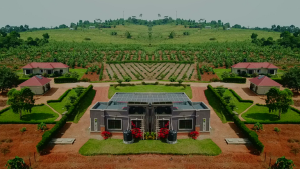
Different Spacing Regimes
As you tour the farm, you will realize that the coffee is spaced differently. Eriki says the recommended spacing for Robusta coffee in Uganda is 3m*3m. However, given the high costs involved especially on labour and fertilizers, they want to increase productivity per unit area.
He says productivity can be increased through fertilizers, irrigation and the number of trees per unit area.
“We decided to do trials on 3m*1m on two acres and 3m*2m on 24 acres. We are also trying 3m*1.5m. I think 3m*2m is okay. 3m*1m and 3m*1.5m spacing are still questionable. We are collecting data and it will inform our future decisions as we expand the farm,” he says.
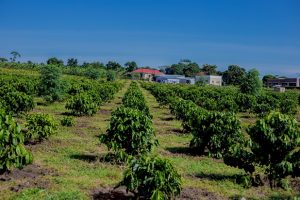
While the farm has different blocks with over 10 acres each, they have also set up small plots of coffee, for example, one acre or less, to examine their performance compared to large scale ones. It has also been done to ensure that both small, medium and large scale farmers who visit the farm learn valuable lessons.
The farm also has Arabica coffee and liberica coffee commonly known as Kisansa on demonstration plots for study/research purposes.
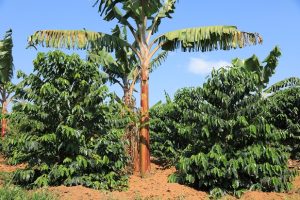
“For 3m*1m spacing, it is better that you don’t train/bend the trees. We are still at observation stage, but we intend to leave one stem,” he says, adding that most of their coffee is currently under 3m*3m spacing. They are currently planting CWD-r varieties, but intend to expand with only high yielding varieties. They also have a mother garden and consequently their own nursery bed.
Production
Eriki says since they inherited older trees, some were not productive enough.
“We have stumped some of them. We are also doing gap filling to ensure we achieve maximum productivity per unit area,” he says.
He adds that their berries are heavy since they are fed well.
“On average, we are able to achieve 3kgs of FAQ/kasse per tree per year,” he says. Indeed, their berries are big as observed by this reporter at the farm’s drying yard. In fact, one of the workers revealed that a sack of kiboko/ dry cherries weighs between 100kg-110kg.
Asked on how they achieve this milestone, Eriki said it’s about consistency in what they do.
“We provide adequate nutrients that are required at the right time. We ensure that the coffee is weed free especially around the canopies. You also need to do pest and disease management on time. How many times do you visit that plot of coffee? For us, we make sure that there’s someone who enters and monitors the coffee on a daily basis. That’s how we quickly respond to every challenge that is there,” he says, adding that their fertilizer application is informed by soil analysis results because they use a scientific approach to farming.
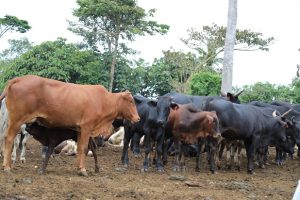
He adds that their soil is a bit more acidic and this means they have to balance the soil through application of recommended fertilizers.
“Here we make sure that the fertilizer has gone to the soil and the plant has picked it up. That’s very important. That’s why you see that even without irrigation, the coffee trees look good. Balancing the soil PH at Heritage Kanaani farms is critical,” he says.
Managing Operational Costs
The farm employs over 200 casual workers yet isn’t yet productive.
Eriki says a properly managed coffee plantation requires proper funding.
“There’s always wastage on many farms. Here we make sure that every coin counts. That’s why all workers are paid for what they have done. We try to minimize wastage and ensure that the system is self-sustaining. We generate some revenue from food crops (mainly cassava and maize) to look after the main project (coffee),” he says, adding that they normally have a combined 200-300 acres of maize and cassava.
He says they don’t have external funding apart from the owner.
“To reduce financial pressure on the owner, we try to create other revenue avenues,” he says. The farm also has 200 acres of eucalyptus and 90 cows utilizing 60 acres of land. The cows provide manure to coffee, while the milk is sold.
The farm also has a dam filled with fish.
“We shall slowly phase out some of the projects as the coffee farm expands,” Eriki says.
The farm also has beehives that produce honey for sale. The bees are also key for coffee fertilization.
“We plan to introduce more beehives in the eucalyptus plantation,” he says.
“It’s not easy running a farm of this magnitude, but we are on the right track” Eriki says.
While he is non-committal on how much is spent in operational costs per month, Eriki says they invest millions of shillings on running the farm.
Quality Assurance
Eriki says the farm has policies and all workers know what is expected of them.
“The farm is run on discipline. All workers know we only pay for well handpicked red ripe cherries. If you pick unripe cherries, you are penalized by not getting paid for every green cherries you picked. You must also sort the green from red cherries,” he says.
He adds that they also have ‘gang’ leaders who supervise not only the picking process, but also other farm activities including weeding, pruning, and fertilizer application among others.
The farm has a very youthful workforce and the youth are given supervision roles too and mentored to enable them succeed. Eriki believes that all the youth need is right leadership and their farm has given them the opportunity to thrive.
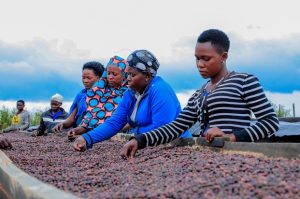
“We have a good supervision system which is another cost. We have also put emphasis on the welfare of the workers. If you want the best out of the farm, take care of your workers. That’s why we have a clinic/sickbay, a SAACO where workers can borrow money and a cinema hall where they can pay little money to watch movies or football. Workers need a conducive environment to give you the best,” he says. The farm also has a canteen.
The workers are paid every two weeks.
He says the farm would probably need more people, but since they are well motivated, they work wholeheartedly.
“They know what is expected of them and can manage themselves but it starts with the farm providing a conducive environment,” he says.
Weed management
The farm mainly uses ring weeding method. The grass in the remaining gaps is slashed using motorized brush cutter machines. The farm has about 10 of these machines. For mature coffee, sometimes herbicides are used. Eriki says the grass grows very fast because the land is near an island.
Value addition
The farm is also adding value to their coffee and honey. The brand name for the farm’s ground and roasted coffee is Kazinga coffee. The name is derived from the fact that they’re around an island (Kazinga in Luganda).
Agro-tourism
The farm has already set up an administrative structure with a board and training room. The farm’s set-up shows that it will be a good agro-tourism centre in the country.
“We have started letting people in. Our dam covers one acre and we are still making it better. You can have a cup of coffee there while watching the fish and the beautiful scenery. You can also have fish,” he says. The farm is also surrounded by Bunjako Island, Lake Victoria and a crocodile farm.
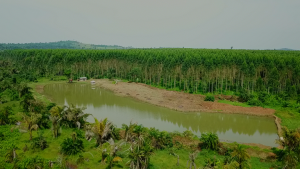
Ugandans can make it
Eriki says having the right people to manage the farm is key. While big plantations in Uganda are mainly managed by Kenyan managers, Eriki says Ugandans can equally do a good job if well empowered.
“Ugandans with big farms should hire professionals to manage them. It is illogical for someone with two square miles of land to hire a school dropout to manage the farm/land. It’s unfair to the agriculture sector,” Eriki says, urging the big players to stop considering farming as a hobby but a business.
“Commercial farming requires proper management, systems and structures at all levels,” he says.
Challenges
Eriki says just like other farms, Heritage Kanaani Farms isn’t immune to challenges. Thieves remain a threat but the farm has set up ‘watch towers’ in different blocks where security personnel stand and watch over a particular block to ensure the coffee isn’t stolen especially during the peak of harvest. The farm also intends to employ advanced technology including use of drones to monitor the farm.
The area also receives ‘abrupt’ rains since it’s surrounding an island, making coffee drying a bit complicated. This means the coffee has to be covered every evening even during the dry spell.
High operational costs also remain a challenge.
“Managing such a big place isn’t easy, especially without any external funding, but we are managing,” he says.
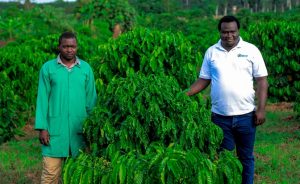
Asked if they have ever received any support from the Government, Eriki said the government has started to support them. It has helped them set up a micro irrigation coffee demo plot.
Future outlook
Eriki says Heritage Kanaani Farms is built on a science-based farming approach. He adds that data and record keeping are a mainstay at the farm.
“We are consistently and accurately collecting data. This will help us to project our future very well. That’s why we are not focusing on how many acres but the number of trees,” he says, adding that the farm currently has over 100,000 coffee trees.
“We have a target of the number of trees we need to break-even. We want to increase productivity per unit area,” he says.
He says they are currently selling their FAQ mainly to exporters. At the moment, they are using raised drying yards but as production increases, this system won’t be sustainable.
“The best system for us would be to have a wet mill factory. If we get financial support in the future, we would like to have a wet mill,” he says, adding that they are also interested in exporting their own coffee.
The farm is also experimenting irrigation on a small scale which will inform their decision on whether to scale it up or not.
“We have the water nearby. We have to maximize our comparative advantage. We have started with small scale irrigation to collect data. We are also collecting rainfall data; we want to know how many milliliters of rain this area receives per year. It will help us to plan better for irrigation,” he says.
For tips or get featured, opinions and advertising, Tel: 0775170346/0703828741/staddewo@gmail.com. Follow us on Twitter: @TaddewoS @BusinessFocusug


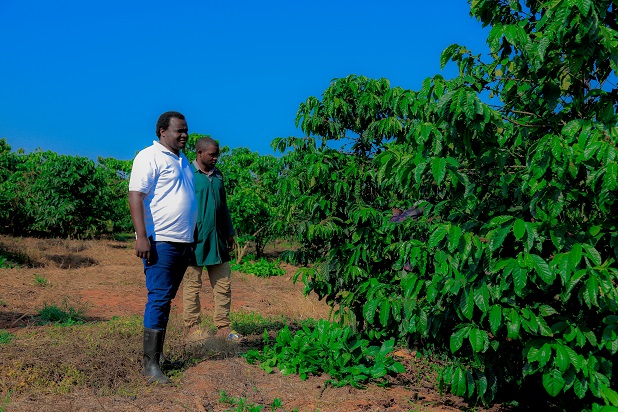

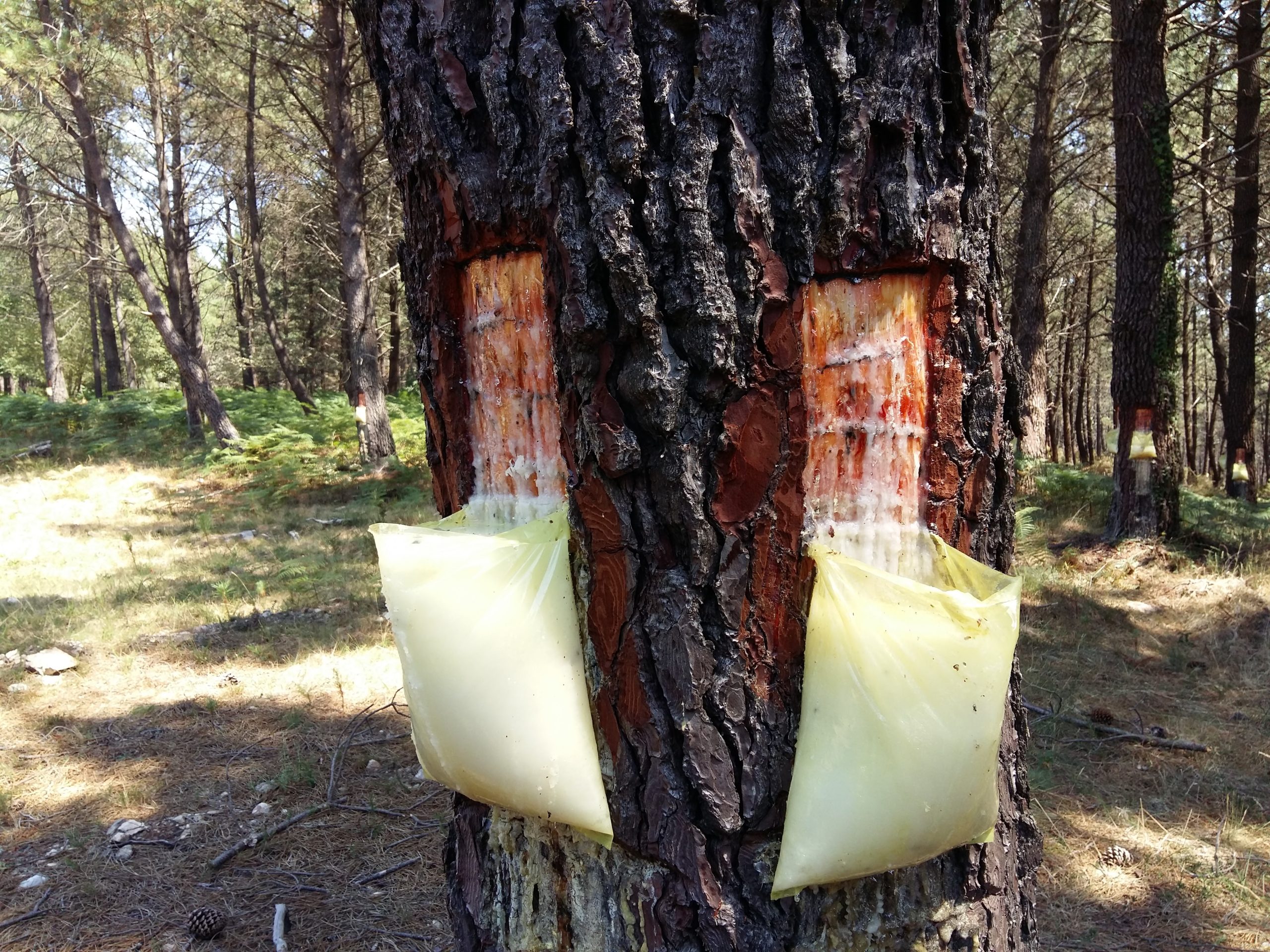

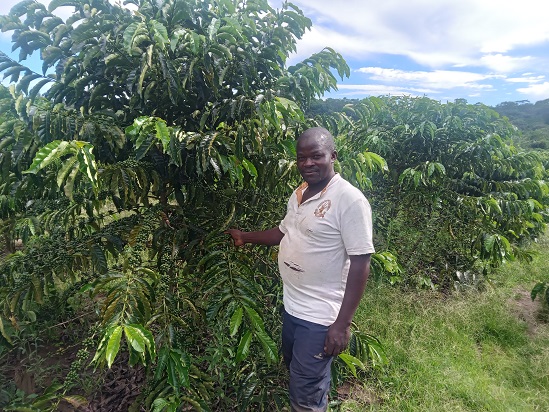
I do have appreciate the work for the company and the advice given to the coffee farmers
thanks guys.
Thanks for the great work you’re doing so encouraging
I love the work
This is so informative and I’ve learnt alot from what is always published here, thanks you very much for tireless research and writing. Continue with the spirit and courage to educate others. Coffee the green God
This is very helpful in transforming the agricultural sector good work done